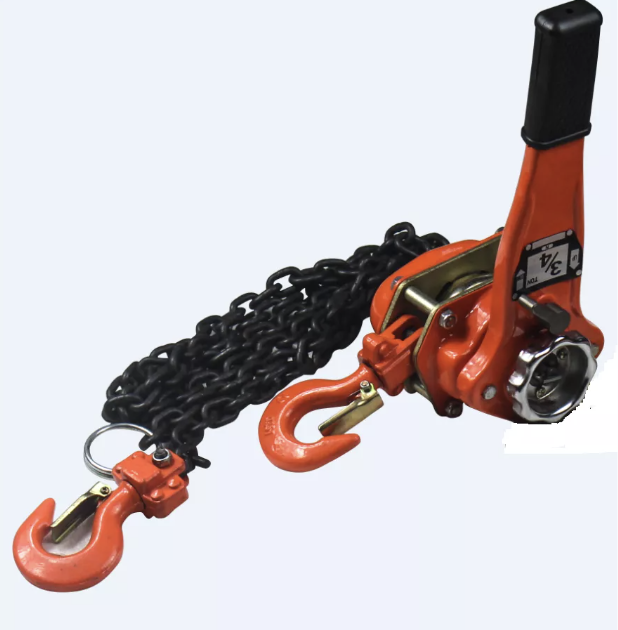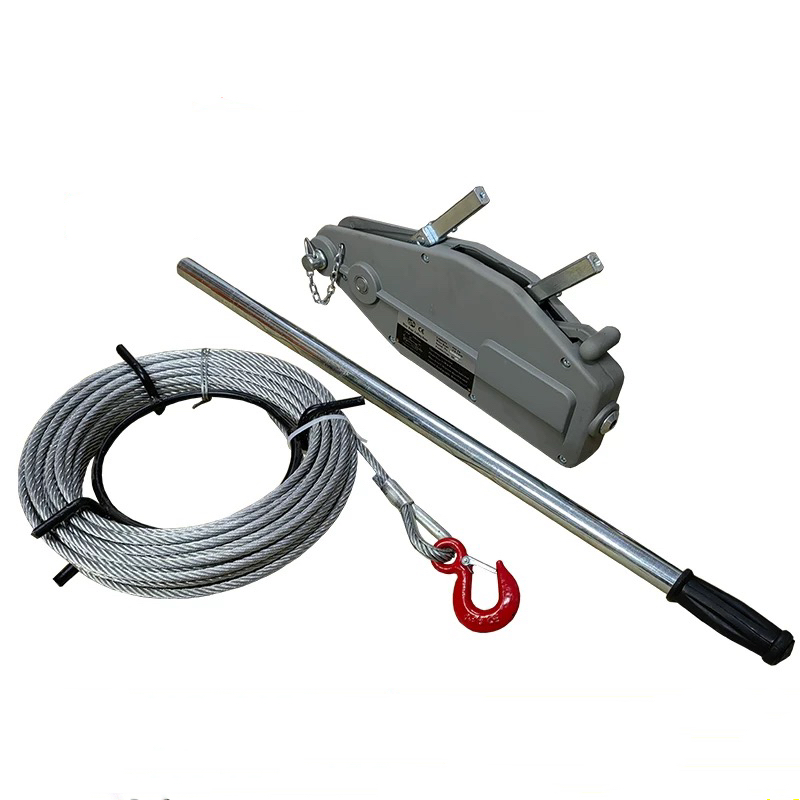
Introduction
Lever hoists are invaluable tools that provide an effective manual solution for lifting and pulling heavy loads. Whether you're working in a construction zone, a warehouse, or a manufacturing facility, a lever hoist offers efficiency and control when handling weights that might otherwise be too difficult to manage manually. This comprehensive guide will take you through every step of how to use a lever hoist safely and effectively, from understanding the core components to providing step-by-step instructions for proper use.
Understanding the fundamentals of operating a lever hoist is crucial, especially in industrial settings where safety and efficiency are paramount. Lever hoists are used in a variety of settings such as construction sites, warehouses, or mechanical workshops where heavy loads must be lifted, pulled, or positioned. However, improper handling can lead to accidents, equipment failure, and even injury. This guide covers everything you need to know to operate a lever hoist correctly, ensuring your safety and the success of your tasks. By the end of this guide, you will be able to operate a lever hoist safely and efficiently, whether you are lifting loads vertically or pulling them horizontally.
What Is a Lever Hoist?
A lever hoist is a mechanical lifting device designed to lift, pull, and position heavy loads manually. It uses a ratchet mechanism, where a lever is pulled to move the load chain, creating a mechanical advantage that makes lifting or pulling heavy items easier. Lever hoists are compact and versatile, often used in tight spaces where other lifting equipment might not fit. Their versatility and simplicity make them ideal tools in areas where electric hoists, cranes, or other automated lifting systems are unavailable or impractical.
Lever hoists can typically handle weights ranging from 0.75 tons up to 10 tons or more, depending on the model and the capacity specified by the manufacturer. They come in various sizes and capacities, and their ease of use makes them an excellent choice for industrial environments that require flexibility and portability.
Key Components of a Lever Hoist
Understanding the components of a lever hoist is essential for proper operation and maintenance. Here’s an overview of the key parts of a lever hoist:
Lever Handle: The lever handle is used to operate the hoist. By pulling the lever, the operator engages the ratchet mechanism, which in turn moves the load chain to lift or pull the load.
Ratchet and Pawl Mechanism: This mechanism is at the heart of the hoist. When the lever is pulled, the pawl engages with the ratchet teeth, causing the load chain to move. This mechanical advantage allows heavy objects to be lifted or moved with minimal effort.
Load Chain: The load chain connects the hoist to the load. It’s the part that moves to either lift or pull the load, depending on the direction of the lever. Chains are designed to withstand significant loads without stretching, making them an integral part of the hoist's operation.
Hooks: The hoist has two hooks—one attaches to the load, and the other attaches to the support point or anchor. The hooks are typically made from forged steel to ensure strength and safety under heavy loads.
Brake Mechanism: This safety feature ensures that the load stays stationary when the hoist is not in operation. It prevents the load from dropping unintentionally, providing a critical safety function during operation.
How Does a Lever Hoist Work?
Lever hoists operate based on the principle of mechanical advantage. The user applies a small amount of force to the lever, which is magnified by the ratchet mechanism, allowing the operator to lift or pull heavy loads. Here’s how the mechanism works:
Lever Operation: When the lever is pulled in one direction, it engages the ratchet mechanism, causing the load chain to move and the load to be lifted or pulled. The user’s input force is amplified by the mechanical components inside the hoist, allowing heavy weights to be moved.
Mechanical Advantage: The lever hoist uses a small force to lift or pull large weights. The longer the lever handle, the greater the mechanical advantage, reducing the amount of physical effort needed. This allows a single operator to move large weights with relatively minimal effort, making it an essential tool in heavy lifting operations.
Load Movement: Depending on the direction of the lever, the load either moves upward (lifting) or along a horizontal plane (pulling). The load chain travels through a sprocket or gear mechanism, which helps move the load smoothly and with precision.
Brake Engagement: Once the load has been moved to the desired position, the brake engages to hold the load securely in place. This prevents the load from falling or shifting when the hoist is not in operation.
Why Mechanical Advantage Matters
The ratchet and pawl mechanism in the lever hoist makes it an excellent tool for lifting and pulling loads that would otherwise be too heavy or cumbersome to handle manually. The ability to generate a mechanical advantage allows a single operator to move large weights with relative ease. This makes lever hoists ideal for use in environments where manual lifting would be inefficient or dangerous. Additionally, the hoist’s compact design means it can be used in tighter spaces where other lifting equipment would be impractical.

How to Use a Lever Hoist Step by Step
Now that we’ve covered the basics of what a lever hoist is and how it works, let’s dive into the detailed process of using a lever hoist. The following sections will provide a comprehensive, step-by-step guide to ensure safe and efficient operation.
Step 1: Inspect the Hoist
Before using the hoist, always perform a thorough inspection. Regular maintenance and checks are essential to ensure the hoist is in good working order. Taking the time to check the hoist beforehand can prevent accidents and help prolong its lifespan.
Load Chain: Check for damage or wear. Ensure the chain is intact and free from kinks or excessive wear. A damaged chain could lead to malfunction during lifting.
Hooks: Inspect both the load hook and the fixed point hook. Ensure they are free from cracks or deformations and that they are securely attached.
Ratchet Mechanism: The ratchet mechanism should move smoothly when the lever is pulled. If there’s resistance or irregular movement, it could be a sign of damage.
Brake Mechanism: Test the brake to ensure it engages and holds the load securely in place when not in use. A malfunctioning brake can be dangerous.
Step 2: Position the Hoist
The positioning of the hoist plays a critical role in how effectively and safely you can lift or pull the load. Depending on the type of lifting or pulling required, positioning can vary. Make sure that the surrounding area is clear of obstacles to avoid unnecessary interference.
For Vertical Lifting: Position the hoist directly above the load. This ensures that the load chain can move vertically without any strain on the hoist or the chain.
For Horizontal Pulling: If you are pulling the load along the ground, ensure the hoist is at the correct angle for efficient movement. Make sure the chain is aligned for a smooth pull.
Always check that the surrounding area is clear of obstacles to prevent interference with the hoist and the load.
Step 3: Attach the Hoist to the Load
Properly attaching the hoist to the load is crucial for both safety and efficiency. Here's how to do it:
Balanced Attachment: The load should be attached to the hoist in a balanced manner to prevent tilting or shifting during lifting or pulling. This ensures that the weight is evenly distributed across the hoist and helps prevent accidents.
Security: Ensure that the hook is properly fastened to the load, and that there’s no chance of the hook disengaging during operation. Double-check the connection before operating the hoist.
Step 4: Operate the Lever Hoist
Now that the hoist is attached to the load, you can begin using the lever to lift or pull it. Lever hoists are designed to be user-friendly, but it is important to follow a smooth and controlled operation:
For Lifting: To lift the load, pull the lever downward. This will engage the ratchet mechanism and cause the load chain to move upwards.
For Horizontal Pulling: If pulling the load horizontally, pull the lever in the opposite direction. The load chain will move the load along the ground, allowing you to position or move it as necessary.
Steady Movements: Always operate the lever with steady, controlled motions. Avoid sudden jerks, as they can cause the load to shift or the hoist to malfunction.
Step 5: Secure the Load
Once the load has been moved to the desired position, engage the brake mechanism to hold the load securely in place. Never leave a load suspended by the hoist without securing it.
Step 6: Lower the Load
To lower the load, reverse the direction of the lever handle.
Controlled Lowering: Lower the load gently and slowly, controlling the speed to ensure the load doesn’t drop too quickly.
Monitor the Load: Keep an eye on the load during lowering to ensure it doesn’t get caught on anything or fall unevenly.
Can a Lever Operated Hoist Be Hung and Operated?
Yes, lever hoists can be hung from an overhead point and operated to lift or pull loads. Hanging the hoist allows gravity to assist in lifting the load, making it a suitable option for vertical lifting.
How to Hang a Lever Hoist:
Choose a Sturdy Mounting Point: Select a secure, overhead point that can support the weight of both the hoist and the load.
Attach the Hoist: Secure the hoist hook to the mounting point using a lifting sling or suitable chain.
Stability Check: Ensure that the hoist is securely attached and stable before proceeding with the lifting operation.
Operate the Hoist: Once the hoist is hung securely, use the lever to begin lifting or pulling the load as needed.
Conclusion
Lever hoists are essential tools in many industries, offering a practical, manual solution for lifting and moving heavy loads. Whether you are lifting machinery, positioning large objects, or pulling items along the ground, knowing how to operate a lever hoist safely and efficiently is essential for completing tasks effectively.
JITAI Electric Power Equipment Co., Ltd. provides high-quality lever hoists designed for heavy-duty use in various industrial settings. Their hoists are built for safety, reliability, and long-lasting performance, making them an excellent choice for professionals in construction, manufacturing, and other industries.
Frequently Asked Questions (FAQ)
1. What Is a Lever Hoist Used For?
Lever hoists are used for lifting, pulling, and positioning heavy loads in various industries, including construction, manufacturing, and warehousing. They are ideal for both vertical and horizontal lifting applications.
2. How Much Weight Can a Lever Hoist Lift?
Lever hoists come in various capacities, typically ranging from 0.75 tons to 10 tons. The specific lifting capacity depends on the hoist model and manufacturer.
3. Can You Use a Lever Hoist in Confined Spaces?
Yes, lever hoists are ideal for confined spaces due to their compact design. They are often used in tight or narrow spaces where larger lifting devices cannot be utilized.
4. How Do You Maintain a Lever Hoist?
To maintain a lever hoist:
Inspect the load chain for wear or damage regularly.
Lubricate the ratchet mechanism and moving parts to keep them functioning smoothly.
Check the brake mechanism to ensure it operates correctly.
Store the hoist in a clean, dry place to prevent rust or corrosion.
5. How Do You Know If a Lever Hoist Is Overloaded?
Most lever hoists come equipped with an overload protection feature. If the hoist is overloaded, the ratchet mechanism may fail to engage correctly, or the load may not move as expected. Always check for signs of wear on the hoist components as well.

















